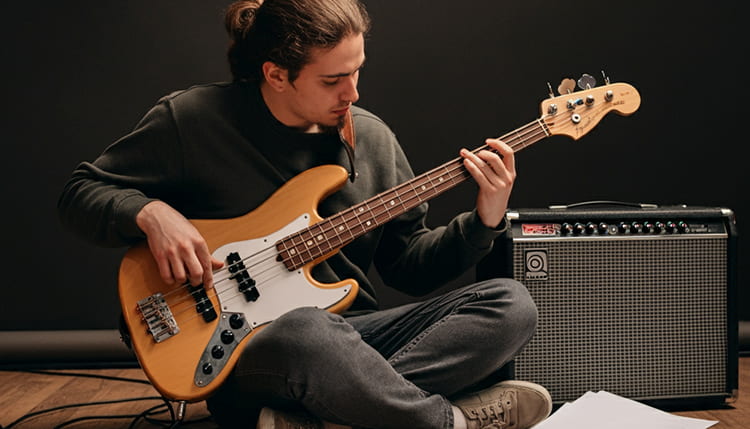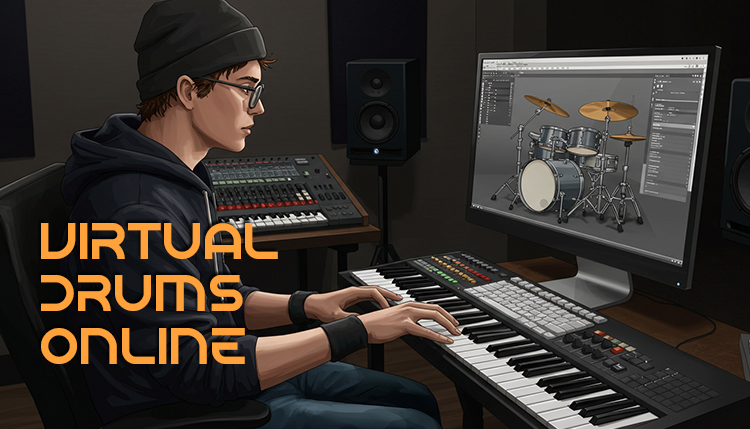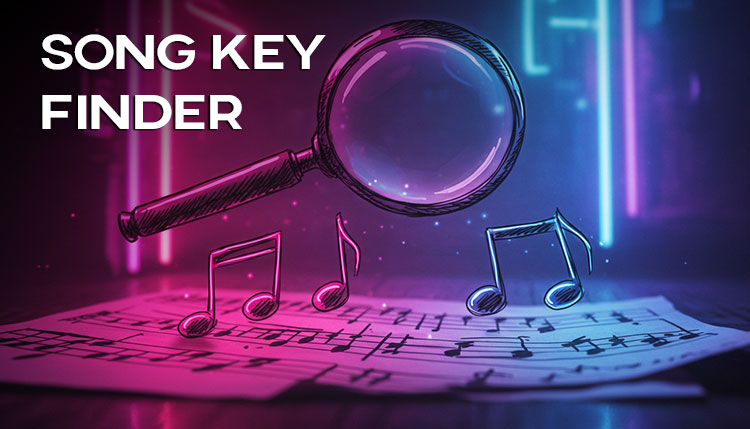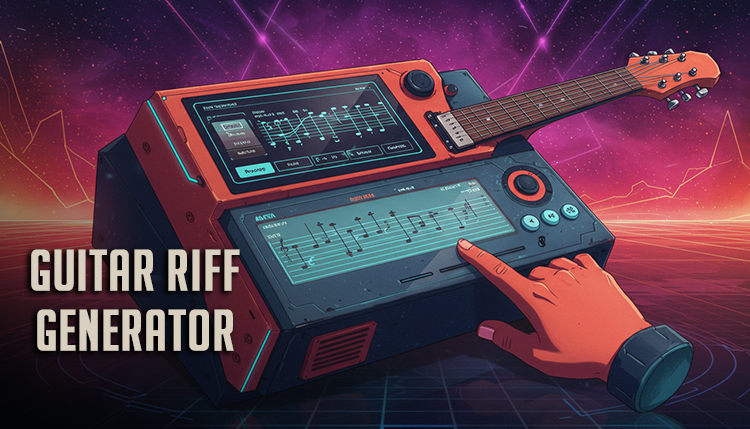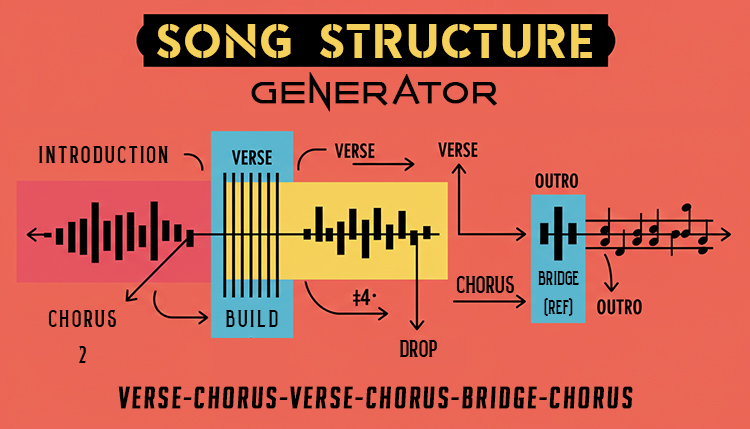Did you know that the bass guitar is often referred to as the “backbone” of a band? It’s true!
This unsung hero provides the crucial foundation that ties together rhythm and harmony in music.
Whether you’re inspired by the groovy lines of Flea from Red Hot Chili Peppers or the melodic bass work of Paul McCartney, learning how to play bass guitar can open up a world of musical possibilities.
In this guide, we’ll walk you through everything you need to know to start your bass-playing journey.
Get ready to unleash your inner groove master!
The Basics of How to Play Bass Guitar
Alright, let’s figure out how to play bass guitar!
I remember when I first picked up a bass – man, was I clueless. But don’t worry, we’ll get you sorted out in no time.
Anatomy of the Bass Guitar
First things first, let’s talk about the anatomy of a bass guitar. You’ve got your strings, fretboard, pickups, and controls.
It might seem like a lot at first, but trust me, it’ll become second nature before you know it.
The strings are where the magic happens – that’s what you’ll be plucking or slapping to create those sweet, low tones.
The fretboard is where you’ll be pressing down to change the pitch of the notes.
And those pickups? They’re like little microphones that capture the sound of your strings and send it to the amp.
Types of Bass Guitars
Now, when it comes to types of bass guitars, you’ve got a few options.
Most beginners start with a 4-string bass, which is what I learned on.
But there are also 5-string and even 6-string basses out there if you’re feeling adventurous.
And don’t forget about fretless basses – they’re a whole different ballgame!
Tuning Your Bass Guitar
Tuning your bass is super important, and it can be a bit tricky at first.
Standard tuning for a 4-string bass is E-A-D-G, from lowest to highest.
But there are some alternative tunings you can experiment with once you get more comfortable.
I remember the first time I tried to tune my bass by ear – let’s just say it didn’t go well!
Proper Posture and Hand Position
One thing that took me way too long to figure out was proper posture and hand positioning. Trust me, you don’t want to develop bad habits early on.
Make sure you’re sitting (or standing) up straight, and that your fretting hand is relaxed.
Your thumb should be on the back of the neck, not wrapped around it like you’re strangling the poor thing!
Here are a few quick tips for getting started:
- Always tune your bass before playing
- Practice with a metronome to improve your timing
- Start with simple bass lines and gradually increase difficulty
- Don’t be afraid to make mistakes – we all do!
Remember, learning bass is a journey, not a destination. It takes time and practice, but it’s so worth it when you start grooving with a band.
Now, let’s move on to some essential techniques for beginners!
Essential Bass Guitar Techniques for Beginners

Alright, now that we’ve got the basics down, let’s talk about some essential techniques you’ll need to master when learning how to play bass guitar.
Trust me, I’ve been through the struggle, and I’m here to help you avoid some of the mistakes I made.
Fingerstyle vs Pick Playing
First up, let’s discuss fingerstyle vs. pick playing. This is a debate that’s been raging in the bass community for ages, and honestly, both methods have their pros and cons.
Personally, I started with fingerstyle because it felt more natural to me.
It gives you a warmer, rounder tone and more control over dynamics.
But don’t knock pick playing – it can give you a punchier sound and is great for fast, precise playing.
I remember the first time I tried playing with a pick – it felt so awkward! But with practice, it became another tool in my arsenal.
Fretting Notes
Next, let’s talk about fretting notes correctly. This is crucial for getting clean, clear tones.
When you’re first starting out, you might find yourself pressing way too hard on the strings. I know I did!
But here’s the thing – you only need to press hard enough to make contact with the fret.
Any harder, and you’re just tiring out your hand and potentially bending the note sharp.
Try to keep your fretting hand relaxed and use the tips of your fingers.
Scales and Arpeggios
Now, let’s get into scales and arpeggios. I know, I know – they’re not the most exciting thing to practice.
But trust me, they’re essential for building finger strength and dexterity.
Start with simple major and minor scales, and work your way up to more complex patterns.
Arpeggios are great for learning the notes of chords and improving your fretboard knowledge.
Basic Rhythms
Lastly, let’s talk about mastering basic rhythms. This is where the bass really shines – we’re the backbone of the rhythm section, after all!
Start with quarter notes and eighth notes, and then move on to more complex rhythms like syncopation.
A tip that really helped me was to practice with a drum loop or metronome. It forces you to stay in time and really lock in with the groove.
Here are some quick tips for practicing these techniques:
- Start slow and gradually increase speed as you get more comfortable
- Focus on one technique at a time to avoid overwhelming yourself
- Record yourself playing and listen back – it’s a great way to catch mistakes
- Don’t forget to have fun! Try playing along with your favorite songs
Remember, everyone learns at their own pace. Don’t get discouraged if you’re not nailing everything right away.
Keep at it, and before you know it, you’ll be grooving like a pro!
Developing Your Bass Playing Skills
Alright, now that we’ve covered the basics and essential techniques, let’s talk about how to really develop your bass playing skills when figuring out how to play bass guitar. This is where the rubber meets the road, folks!
Practice Routines
First things first, let’s talk about practice routines. I can’t stress enough how important it is to have a structured practice schedule.
When I first started, I’d just noodle around aimlessly for hours. Don’t get me wrong, that can be fun, but it’s not the most efficient way to improve.
Try to set aside a specific time each day for practice, even if it’s just 15-30 minutes.
And make sure you’re covering all your bases (pun intended) – scales, techniques, songs, and ear training.
Ear Training
Speaking of ear training, this is something that a lot of beginners overlook, but it’s crucial for becoming a well-rounded bassist.
Start by trying to recognize intervals – the distance between two notes. Then move on to identifying chord progressions.
I remember when I first started ear training, it felt like I was learning a whole new language.
But stick with it, and you’ll be amazed at how much it improves your playing.
Reading Music
Now, let’s talk about reading music. I know, I know, it’s not the sexiest part of playing bass, but it’s incredibly useful.
Learn how to read guitar tablature, which is a simplified way of notating bass lines.
Once you’re comfortable with that, try your hand at standard notation.
It might seem daunting at first, but it opens up a whole world of musical possibilities.
Play with Tracks
One of the best ways to improve your playing is by jamming with backing tracks or a metronome.
This helps you develop your timing and groove, which are essential for any bassist.
I remember the first time I played with a real drummer – it was a total game-changer!
But until you find your own rhythm section, backing tracks are a great alternative.
Here are some tips for developing your skills:
- Use a practice journal to track your progress
- Try to learn at least one new song or technique each week
- Don’t just practice what you’re good at – focus on your weak areas too
- Listen to a wide variety of music to expand your musical vocabulary
Remember, developing your skills is a lifelong journey. Even after playing for years, I’m still learning new things all the time.
The key is to stay curious and keep pushing yourself.
Before you know it, you’ll be laying down grooves that make people want to get up and dance!
Daily Bass Guitar Scale Practice Routine
1. Major Scale Pattern
Practice this one-octave major scale pattern:
G |-----------------------------------|
D |---------------------------2-4-5---|
A |---------------2-4-5-7-9------------|
E |-5-7-9-10-12------------------------|
2. Minor Scale Pattern
Then practice this one-octave minor scale pattern:
G |-----------------------------------|
D |---------------------------2-3-5---|
A |---------------2-3-5-7-8------------|
E |-5-7-8-10-12------------------------|
Practice Steps:
- Start slow, about 60 BPM.
- Play each scale ascending and descending.
- Focus on playing each note clearly and evenly.
- Gradually increase speed as you become more comfortable.
- Practice each scale for 5-10 minutes daily.
- Once comfortable, try starting the patterns on different frets to play in different keys.
Remember: Consistency is key. Even 15-20 minutes of daily practice will yield significant improvements over time.
Exploring Different Bass Playing Styles
Alright, let’s get into the fun stuff – exploring different bass playing styles!
This is where you really get to develop your own voice as a bassist.
Rock and Pop Bass Guitar
First up, let’s talk about rock and pop bass lines. These are often the foundation of many beginners’ playing, and for good reason.
They’re usually straightforward and groove-oriented, which makes them great for learning.
I remember when I first learned the bass line to “Another One Bites the Dust” by Queen – I felt like a rock star!
Start with simple root-fifth patterns and gradually work your way up to more complex lines.
Funk and R&B Bass Guitar
Now, if you want to add some spice to your playing, you’ve gotta check out funk and R&B bass.
This is where techniques like slap and pop come into play.
I’ll be honest, when I first tried slapping, I sounded more like I was swatting flies than playing bass.
But with practice, it becomes an incredibly fun and expressive technique.
Start with simple thumb slaps on the low strings and gradually add in pops on the higher strings.
Jazz Bass Guitar
For those looking to challenge themselves, jazz bass is a whole other world.
Walking bass lines are the foundation of jazz bass playing, and they’re a great way to improve your fretboard knowledge and improvisation skills.
I remember struggling with walking bass lines at first – it felt like trying to pat my head and rub my stomach at the same time. But once it clicks, it’s incredibly satisfying.
Latin and World Bass Guitar
Lastly, don’t forget about Latin and world music bass styles.
These can add a whole new dimension to your playing with their diverse rhythms and grooves.
Try learning some basic salsa or bossa nova patterns – they’re a great way to improve your timing and feel.
Here are some tips for exploring different styles:
- Listen to bassists in each genre to get a feel for the style
- Start with simple patterns and gradually increase complexity
- Don’t be afraid to mix and match techniques from different styles
- Remember that feel is just as important as technical skill
The great thing about bass is that there’s always something new to learn.
Each style has its own unique challenges and rewards.
So don’t limit yourself – explore, experiment, and find what resonates with you.
Who knows, you might discover a style that becomes your signature sound!
Essential Bass Guitar Gear and Accessories
Alright, let’s talk gear! This is the part where you get to geek out a bit about all the cool stuff that goes along with playing bass.
Choosing Your Bass Guitar
First up, choosing the best bass guitar for beginners.
Man, I remember when I bought my first bass – I was so excited, but also totally overwhelmed by all the options.
Here’s the thing: you don’t need to break the bank on your first instrument.
Look for something comfortable to play with decent build quality.
Brands like Squier, Yamaha, and Ibanez make great beginner basses.
And don’t be afraid to buy used – the Guitar Center used gear section has great deals on secondhand instruments.
Bass Amps and Effects
Now, let’s talk about amplifiers and effects pedals. Your amp is just as important as your bass when it comes to your overall sound.
For beginners, a solid-state combo amp is usually the way to go. And yes bass amps are different from electric guitar amps.
As for effects, start simple – maybe a basic overdrive or fuzz pedal to start with.
I remember getting my first distortion pedal and going absolutely nuts with it – everything I played sounded like a swarm of angry bees!
Strings, Picks and Straps
When it comes to strings, picks, and straps, it’s all about personal preference.
Experiment with different types of strings to find what feels and sounds best to you.
Same goes for picks – try different thicknesses and materials. And don’t skimp on a good strap – your back will thank you later.
Maintenance and Care
Lastly, let’s talk about maintenance and care for your bass.
How to clean a guitar is something I learned the hard way after neglecting my first bass.
Clean your strings after playing, wipe down the body and neck, and store it in a case when not in use.
And don’t forget to change your strings regularly – old, dead strings can really kill your tone.
Here are some quick tips for gear:
- Try before you buy whenever possible
- Don’t feel pressured to buy expensive gear right away
- Invest in a good tuner – it’s essential for any bassist
- Consider taking your bass to a professional for setup and maintenance
Remember, the most important thing is finding gear that inspires you to play.
It doesn’t have to be the most expensive or flashy equipment – just something that feels good and sounds good to you.
Now get out there and start grooving!
Overcoming Common Challenges for New Bass Players
Alright, let’s talk about some of the hurdles you might face as a new bass player.
Trust me, we’ve all been there, and I’m here to tell you that you can overcome these challenges!
Building Endurance
First up, let’s address the elephant in the room – developing finger calluses and building endurance.
When I first started playing, my fingers felt like they were on fire after just a few minutes of practice. But here’s the thing – it gets better!
Your fingers will toughen up over time, and you’ll be able to play for longer without discomfort.
Just remember to take breaks if you’re experiencing pain, and don’t overdo it at first.
Hand Movements
Next, let’s talk about coordinating left and right hand movements.
This can feel like trying to pat your head and rub your stomach at the same time when you’re first starting out.
I remember feeling so uncoordinated, like my hands were working against each other.
The key here is to start slow. Practice simple patterns at a tempo where you can play cleanly, then gradually increase the speed as you get more comfortable.
Timing and Groove
Improving timing and groove is another big challenge for many new bassists.
After all, we’re part of the rhythm section – we need to be rock solid!
One thing that really helped me was practicing with a metronome.
I know, it’s not the most exciting thing in the world, but it’s incredibly effective.
Start with simple quarter note patterns and work your way up to more complex rhythms.
Performance Anxiety
Finally, let’s address performance anxiety and stage fright.
This is something that affects even experienced musicians, so don’t feel bad if you’re nervous about playing in front of others.
I still get butterflies before gigs sometimes! The best way to overcome this is through exposure.
Start by playing for friends or family, then work your way up to open mics or jam sessions.
Remember, everyone in the audience wants you to succeed!
Here are some tips for overcoming these challenges:
- Be patient with yourself – progress takes time
- Practice regularly, even if it’s just for short periods
- Record yourself playing and listen back to identify areas for improvement
- Don’t compare yourself to other players – focus on your own progress
Remember, every bassist you admire started exactly where you are now.
They faced these same challenges and overcame them, and you can too.
Keep at it, stay positive, and before you know it, you’ll be laying down grooves like a pro!
You Now Know How to Play Bass Guitar
Congratulations! You’re now equipped with the knowledge to begin your bass guitar journey.
Remember, learning an instrument is a lifelong adventure, so be patient with yourself and enjoy the process.
As you practice and develop your skills, you’ll soon find yourself laying down grooves that make people want to move.
Don’t be afraid to experiment, explore different styles, and most importantly, have fun!
The world of bass playing is vast and exciting – so grab your bass, start plucking those strings, and let the rhythm flow through you.
Who knows? You might just become the next legendary bassist!


